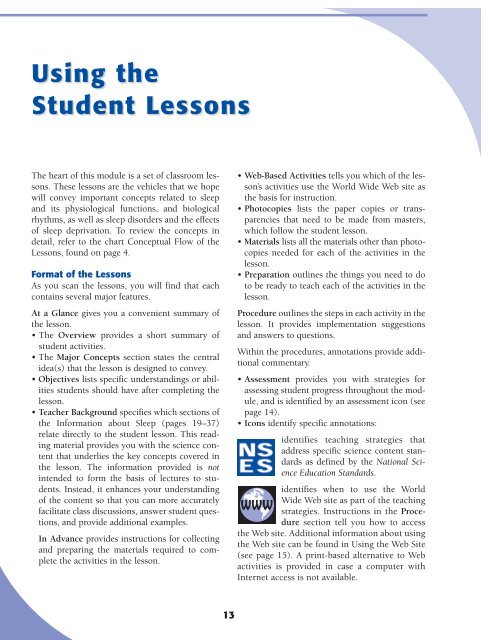Biological - NIH Office of Science Education - National Institutes of ...
Biological - NIH Office of Science Education - National Institutes of ...
Biological - NIH Office of Science Education - National Institutes of ...
Create successful ePaper yourself
Turn your PDF publications into a flip-book with our unique Google optimized e-Paper software.
Using the<br />
Student LessonsL<br />
The heart <strong>of</strong> this module is a set <strong>of</strong> classroom lessons.<br />
These lessons are the vehicles that we hope<br />
will convey important concepts related to sleep<br />
and its physiological functions, and biological<br />
rhythms, as well as sleep disorders and the effects<br />
<strong>of</strong> sleep deprivation. To review the concepts in<br />
detail, refer to the chart Conceptual Flow <strong>of</strong> the<br />
Lessons, found on page 4.<br />
Format <strong>of</strong> the Lessons<br />
As you scan the lessons, you will find that each<br />
contains several major features.<br />
At a Glance gives you a convenient summary <strong>of</strong><br />
the lesson.<br />
• The Overview provides a short summary <strong>of</strong><br />
student activities.<br />
• The Major Concepts section states the central<br />
idea(s) that the lesson is designed to convey.<br />
• Objectives lists specific understandings or abilities<br />
students should have after completing the<br />
lesson.<br />
• Teacher Background specifies which sections <strong>of</strong><br />
the Information about Sleep (pages 19–37)<br />
relate directly to the student lesson. This reading<br />
material provides you with the science content<br />
that underlies the key concepts covered in<br />
the lesson. The information provided is not<br />
intended to form the basis <strong>of</strong> lectures to students.<br />
Instead, it enhances your understanding<br />
<strong>of</strong> the content so that you can more accurately<br />
facilitate class discussions, answer student questions,<br />
and provide additional examples.<br />
In Advance provides instructions for collecting<br />
and preparing the materials required to complete<br />
the activities in the lesson.<br />
• Web-Based Activities tells you which <strong>of</strong> the lesson’s<br />
activities use the World Wide Web site as<br />
the basis for instruction.<br />
• Photocopies lists the paper copies or transparencies<br />
that need to be made from masters,<br />
which follow the student lesson.<br />
• Materials lists all the materials other than photocopies<br />
needed for each <strong>of</strong> the activities in the<br />
lesson.<br />
• Preparation outlines the things you need to do<br />
to be ready to teach each <strong>of</strong> the activities in the<br />
lesson.<br />
Procedure outlines the steps in each activity in the<br />
lesson. It provides implementation suggestions<br />
and answers to questions.<br />
Within the procedures, annotations provide additional<br />
commentary.<br />
• Assessment provides you with strategies for<br />
assessing student progress throughout the module,<br />
and is identified by an assessment icon (see<br />
page 14).<br />
• Icons identify specific annotations:<br />
identifies teaching strategies that<br />
address specific science content standards<br />
as defined by the <strong>National</strong> <strong>Science</strong><br />
<strong>Education</strong> Standards.<br />
identifies when to use the World<br />
Wide Web site as part <strong>of</strong> the teaching<br />
strategies. Instructions in the Procedure<br />
section tell you how to access<br />
the Web site. Additional information about using<br />
the Web site can be found in Using the Web Site<br />
(see page 15). A print-based alternative to Web<br />
activities is provided in case a computer with<br />
Internet access is not available.<br />
13

















